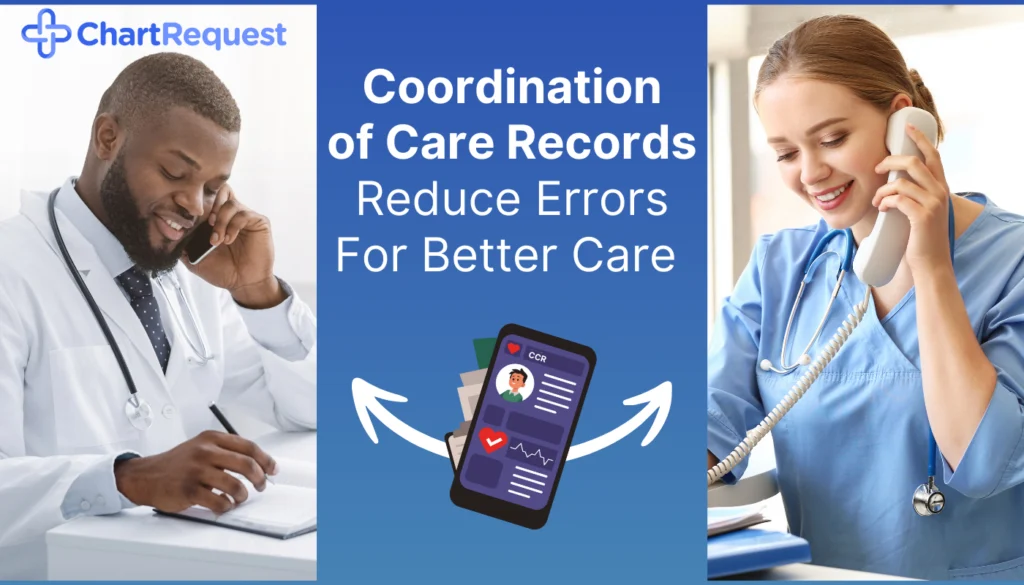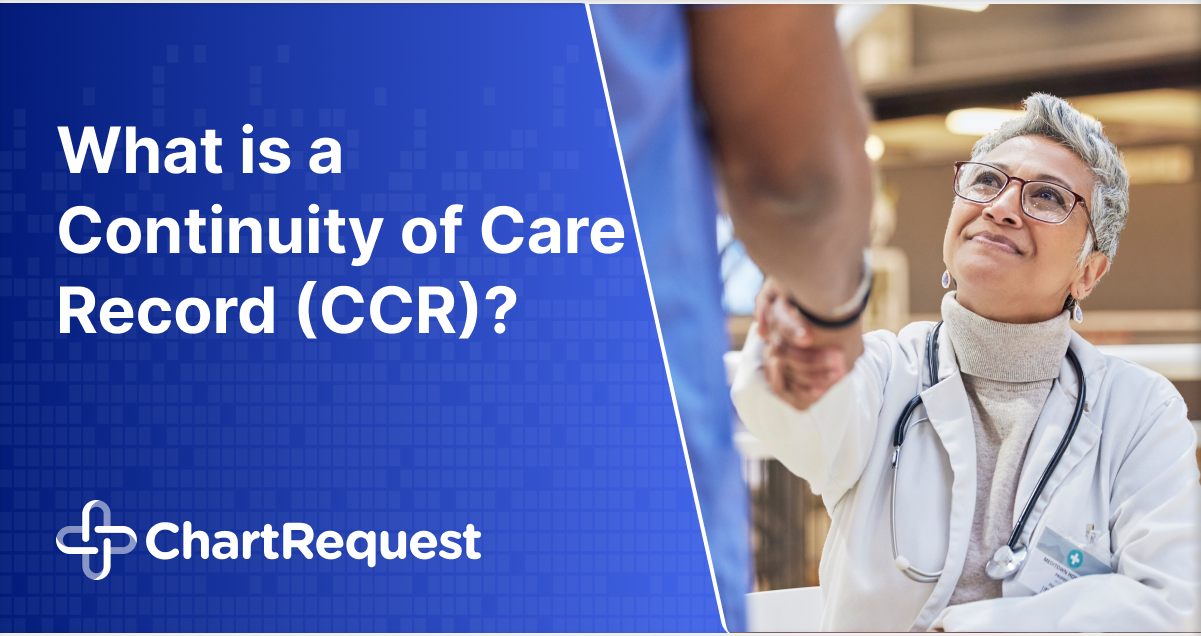Healthcare providers’ primary goal is helping patients achieve lasting health, and the Continuity of Care Record (CCR) is a common standard that helps with collaboration.
Did you know that 80% of major medical mistakes occur due to incorrect information during patient handoffs? Studies show that using digital records can cut these errors by 30% to 40%.
In this article, we will discuss what a Continuity of Care Record (CCR) is and how ChartRequest can help you enhance care coordination.
What is the Purpose of the CCR?
Continuity of care records require providers to ensure seamless patient care, no matter who they see or where they go for treatment.

That’s where the Continuity of Care Record comes into play. Here’s what you need to know:
- It’s like a patient’s medical resume: Think of the CCR as a detailed summary of a patient’s medical history. It includes everything, such as past doctor visits, any medicines they’re taking, and their allergy information.
- Continuity of care records help doctors get up to speed: With a CCR, any new doctor can quickly understand a person’s health background. This means they can start helping patients faster, without digging through many old files.
- They boost healthcare efficiency: By having essential patient information in one place, healthcare providers can avoid repeating tests or treatments to save time and reduce costs.
- Supports better health outcomes: A study found that patients receive better care when doctors have complete patient records. Access to comprehensive patient information can lower hospital readmission rates.
Continuity of care records also make care coordination easier for healthcare providers and more impactful for patients. It’s a win-win for everyone involved in the healthcare process.
For healthcare providers: the CCR simplifies passing on patient health information, making a doctor’s job easier and helping them provide better care.
For patients: the CCR gives them peace of mind knowing their providers can get and share their medical information to help provide the right treatments at the right time.
The Shift to Digital Continuity of Care Records
When we talk about the Continuity of Care Record (CCR), we mean keeping track of health information so every doctor or nurse quickly knows a patient’s medical history.
Think of the CCR as the ultimate summary of a patient’s health story. It captures major events and details to help healthcare providers ensure patients get the best care possible.
Here’s a breakdown of the key components that make it so valuable:
What’s Inside a CCR?
Each component of the CCR is important to a patient’s overall care. Sometimes, one small detail can make the difference, and this attention to detail keeps patients safe, healthy, and informed.
- Patient Information: The basics, such as patient names, birth dates, and important numbers that identify them.
- Healthcare Provider Details: This is essential information about the doctors and nurses who have contributed to a patient’s care.
- Diagnoses: This section lists any conditions or illnesses. It’s crucial because it informs future care plans and helps new doctors understand treatments so far.
- Medications: Whether it’s a one-time antibiotic or a daily heart medication, this part is important for preventing medicinal mix-ups and ensuring new treatments don’t clash with existing care.
- Allergies: This section informs healthcare providers about any patient allergies to prevent negative reactions to medicine.
- Immunizations: Keeping track of vaccines prevents unnecessary repeats and ensures patients are protected against severe diseases.
- Care Plans: These outline any ongoing treatment plans, such as physio for a bad back or counseling. They help keep care consistent and goal-oriented.
This comprehensive data can make a major difference. Did you know the Journal of the American Medical Informatics Association reported that accurate electronic health records, like a well-maintained CCR, can lower medication errors by up to 50%?
How Continuity of Care Records Are Used
In the world of healthcare, keeping everything connected is a big deal. The Continuity of Care Record (CCR) acts like a bridge, ensuring that doctors can see a patient’s health history from anywhere.
Remember, the key here is the “continuity” part of continuity of care. Whether a patient is moving to a new city, seeing a specialist, or winding up in an emergency room, a comprehensive CCR ensures they’re not starting from square one every time.
But how is it actually used? Whether you’re a healthcare professional or a patient, understanding the CCR can make a big difference. Here’s a simple breakdown:
For Healthcare Providers
- Quick Access to Patient History: With a CCR, you can quickly see a patient’s health background, allergies, medications, and more. This means you can make informed decisions faster.
- Easy Sharing Between Teams: If a patient is seeing multiple specialists, CCRs make it easy to keep everyone in the loop. This ensures that treatments are not conflicting and care is coordinated.
- Updating Records: After each visit or treatment, you’ll need to update the patient’s CCR. This keeps their health story current.
For Patients
- Know Your Health Story: Your CCR is a patient’s health story. Understanding it helps patients track health changes and treatments over time.
- Sharing with New Doctors: When you visit a new doctor, sharing your CCR can help them understand your health quickly. This is especially useful if you’re seeing a specialist or have a complex health history.
- Accessing Your Records: Nowadays, tools like ChartRequest help patients access their CCR online. It’s a good idea to review yours regularly and make sure it’s up to date.
History of the Continuity of Care Record (CCR)
The Continuity of Care Record (CCR) has a rich history in healthcare information technology. It represents a big leap in how medical professionals share and manage patient information.
Let’s dive into its origins, key developments, and how it shifted from paper to digital formats.
Origins of the Continuity of Care Record Concept in Healthcare IT
The idea of the CCR began in the early 2000s. Healthcare professionals wanted a better way to share important patient information quickly and accurately. Before CCR, sharing patient data was slow and often incomplete because many providers hadn’t yet adopted EMR systems.
The goal was to create a standard method to share patient health details so every caregiver could provide the best care.
Development Milestones and the Role of Standards Organizations
- Early 2000s: The push for a standardized healthcare record began.
- ASTM International: This organization played a huge role in creating the CCR standards. They made sure the CCR had everything needed to give a complete view of a patient’s health.
- Adoption by Healthcare Providers: Over time, more doctors, hospitals, and clinics started to use CCRs. They saw how useful they could be in improving patient care.
Standards organizations like ASTM International were crucial. They set the guidelines for what information a CCR should contain. This helped ensure every CCR was thorough and useful, no matter where it was created.
Evolution from Paper-Based Records to Digital Formats
We’re seeing more and more records go digital for a good reason. A study by the National Institutes of Health shows that digital records can reduce errors by up to 85% compared to paper records.
Looking ahead, the trend is clear: more tech in healthcare. Here’s how it happened:
- Late 1990s to Early 2000s: Most patient records were on paper. This made sharing information slow and prone to errors.
- Digital Revolution: As technology improved, healthcare shifted towards digital records. This made it easier and faster to share and update patient information.
- Today: Electronic medical record systems are almost universally used, but poor interoperability created data silos that can be addressed with record exchange solutions.
Today, almost all CCRs are digital. This allows for quick updates, easy sharing, and better security of patient data.
Benefits of the Continuity of Care Record
The continuity of care record (CCR) is an important tool for empowering everyone involved in providing patient care. It has many advantages, but let’s focus on a few:
- Improved Patient Care: Continuity of Care Records help patients get the best care possible by giving providers quick and easy access to important information.
- Streamlining Healthcare Operations and Reducing Costs: Time is money. The CCR helps save both. No more unnecessary repeat tests or treatments because the new doctor didn’t know the last one already tried that.
- Supporting a Great Patient Experience: Patients have one goal when they see a healthcare provider: improve their health. By collaborating with other providers, you can prioritize the most important pillar of providing an excellent patient experience.
A study in the Journal of General Internal Medicine found that doctors’ access to electronic health information significantly reduces the chance of emergency hospital admissions. That’s just one example of how powerful this tool can be for a patient’s health.
CCR vs. CCD (Continuity of Care Document)
In the world of healthcare IT, two important formats help share patient information: the Continuity of Care Record (CCR) and the Continuity of Care Document (CCD). Both play big roles in continuity of care, but they have some key differences.
Let’s look at what sets them apart and when one might be used over the other.
CCR vs. CCD: What’s the Difference?
- CCR (Continuity of Care Record)
- Structure: It is designed to be simple and flexible, making it easy for different healthcare systems to adopt and use.
- Content: It focuses on the most essential health information, like allergies, medications, past illnesses, and treatments.
- Usage: Best for quick transfers of patient information across various healthcare settings.
- CCD (Continuity of Care Document)
- Structure: More detailed and standardized, following strict guidelines for formatting.
- Content: Includes everything in a CCR, plus more detailed clinical notes, lab results, and patient instructions.
- Usage: Ideal for comprehensive patient records that require detailed medical histories and are often used in long-term care planning.
Key Differences in Structure, Content, and Usage
The main differences between CCR and CCD lie in their level of detail and flexibility. CCRs are simpler, making them quicker to produce and share. On the other hand, CCDs provide a more comprehensive view of a patient’s medical history but require more effort to create and interpret.
Situational Advantages of Each Format
- CCR: Great for emergency situations where time is critical and healthcare providers need immediate access to a patient’s key health information.
- CCD: Better suited for ongoing care management where a detailed patient history is necessary to make informed decisions.
Both CCR and CCD are helpful for the continuity of care. The choice between them depends on the specific needs of the healthcare scenario—whether the priority is speed and simplicity (CCR) or detail and depth (CCD).
Enhance Your Care Coordination Strategy
Achieving excellent care outcomes can be a shared effort between multiple healthcare providers, but keeping everyone informed is challenging. ChartRequest aims to support your care coordination to help you get the most out of your CCRs.
Whether you would like to support your record release team with streamlined software or get the release of information off your plate, there’s a solution. You can also set up a personalized consultation to explore which solutions may be best for you.


